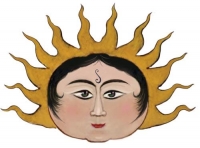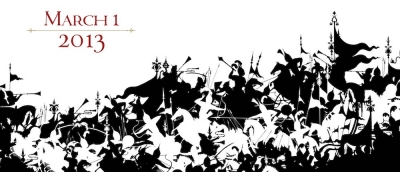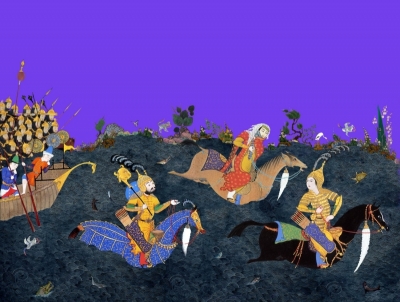Shahnameh: The Epic of the Persian Kings
Media
Mission

A little over a thousand years ago a Persian poet named Ferdowsi of Tous collected and put into heroic verse the millennium old mythological and epic traditions of Iran. It took him thirty years to write the sixty thousand verses that comprise the Shahnameh (The Book of Kings). This monumental tome is one of the most important literary works of Iran and like other great epics, such as Gilgamesh, The Odyssey, Nibelungenlied and Ramayana, it is a record of the human imaginative consciousness. It is well known and has been adapted through out the Near East, Central Asia and India but is mostly unknown in the West.
Shahnameh: The Epic of the Persian Kings

Shahnameh: The Epic of the Persian Kings is a new illustrated edition of the classic work written over one thousand years ago by Abolqasem Ferdowsi, one of Persia’s greatest poets. This new prose translation of the national epic is illuminated with over 500 pages of illustrations and will be published in March 2013 to coincide with the Persian New Year, Nowruz.
The lush and intricate illustrations in this edition have been created by award-winning graphic artist and filmmaker Hamid Rahmanian, incorporating images from the pictorial tradition of the Persianate world from the fourteenth to the nineteenth centuries. The new translation and adaptation by Ahmad Sadri, retells the mythological and epic stories of the original poem in prose format. This Shahnameh is an extraordinary literary and artistic accomplishment.
Published by The Quantuck Lane Press, distributed by W. W. Norton & Company
Hardcover with slipcase, 592 pages, 500+ four-color illustrations
ISBN 978-1-59372-051-3

About Shahnameh
A little over a thousand years ago a Persian poet named Ferdowsi of Tous collected and put into heroic verse the millennium old mythological and epic traditions of Iran. It took him thirty years to write the sixty thousand verses that comprise the Shahnameh (The Book of Kings). This monumental tome is one of the most important literary works of Iran and like other great epics, such as Gilgamesh, The Odyssey, Nibelungenlied and Ramayana, it is a record of the human imaginative consciousness. It is well known and has been adapted through out the Near East, Central Asia and India but is mostly unknown in the West.
The stories of the Shahnameh tell the long history of the Iranian people. It begins with the creation of the world and the origin myths of the arts of civilization (fire, cooking, metallurgy, social structures, etc.) and ends with the Arab conquest of Persia in the seventh century, A.C.E. A mix of myth and history, the characters of Shahnameh take the readers on heroic adventures filled with superhuman champions, magical creatures, heart-wrenching love stories, and centuries-long battles.
Ferdowsi was grieved by the fall of the Persian Empire. Shahnameh was meant to harbor the Persian collective memory, language, and culture amidst a turbulent sea of many historical storms and to preserve the nostalgia of Persia’s golden days.
Heroes of Shahnameh are often torn between incompatible loyalties: moral duty against group obligations, filial piety against national honor, etc. Some Iranian kings and heroes appear in Shahnameh as shining examples of courage and nobility. Others are portrayed as flawed human beings who lose their divine “charisma,” their loved ones, and even their own lives to pettiness and hubris. Ferdowsi stresses his belief that since the world is transient, and since everyone is merely a passerby, one is wise to avoid cruelty, lying, avarice and other evils; instead one should strive for order, justice, honor. truth and other virtues.
Shahnameh has survived as the embodiment of the pre-Islamic Persian soul, but it is much more than a national treasure. As a document of human collective consciousness, it reflects the dilemmas of the human condition as it confronts us with the timeless questions of our existence.
The present version covers the brief mythological opening of Shahnameh as well as the main bulk of its epic stories. The last one third of the book that is dedicated to the tales of the last pre-Islamic dynasty of Iran and the Arab conquest is not part of this version of Shahnameh.
Team
Hamid Rahmanian, Illustrator, Designer
Hamid Rahmanian is an award-winning filmmaker and graphic artist whose work has been exhibited in international competitions and publications. His narrative and documentary films have premiered at Venice, Sundance, Toronto, Tribeca, and IDFA film festivals. He has won numerous international awards and his works have been televised on international networks, including PBS, Sundance Channel, IFC, Channel 4, BBC, DR2, and Al Jazeera. He lives in Brooklyn, New York. For more information visit:www.hamidrahmanian.com
Dr. Ahmad Sadri, Translation and Adaptation
Ahmad Sadri is professor of Sociology and Anthropology and James P. Gorter Chair of Islamic World Studies at Lake Forest College. He is the author of Max Weber’s Sociology of Intellectuals published by Oxford University Press and selected as the 1993 academic book of the year by Choice, the publication of American Library Association. He has written two books in Persian, Reviving the Concept of Civilizations and An Apocalypse Soon, and his published translations include Saddam City (from Arabic) and Reason, Freedom and Democracy in Islam (from Persian). He lives in Gurnee, Illinois.
Melissa Hibbard, Editorial Director
Melissa Hibbard is an independent writer and producer. Her latest film, THE GLASS HOUSE (2008), produced in association with the Sundance Channel received several awards including the prestigious Human Rights Award (OSCE). Her films have been well received by critics and audiences and have been part of Sundance, Tribeca, Venice, IDFA and Toronto film festivals and been broadcast on international networks around the world. She lives in Brooklyn New York. For more information visit www.fictionvillestudio.com
Sheila Canby, Foreword
Sheila Canby is the Curator in Charge of the Islamic Art Department at the Metropolitan Museum of Art. Previously she was Curator of Islamic Collections at the British Museum. Her publications include Persian Painting and The Golden Age of Persian Art. She lives in New York City.
Jim Mairs, Publisher – Quantuck Lane Press
Jim Mairs has been an editor at Norton for over forty years. The critically acclaimed RED BOOK of Carl Jung is one of his recent accomplishments. Ten years ago he started his own company, The Quantuck Lane Press, where he specializes in beautifully produced books on art and other imaginative subjects.
This book is a production of Fictionville Studio
Fiscal Sponsorship provided by Rattapallax
Website developed by Mani Nilchiani
Contact
All Productions & Campaigns
- ‹‹
- 2 of 2



